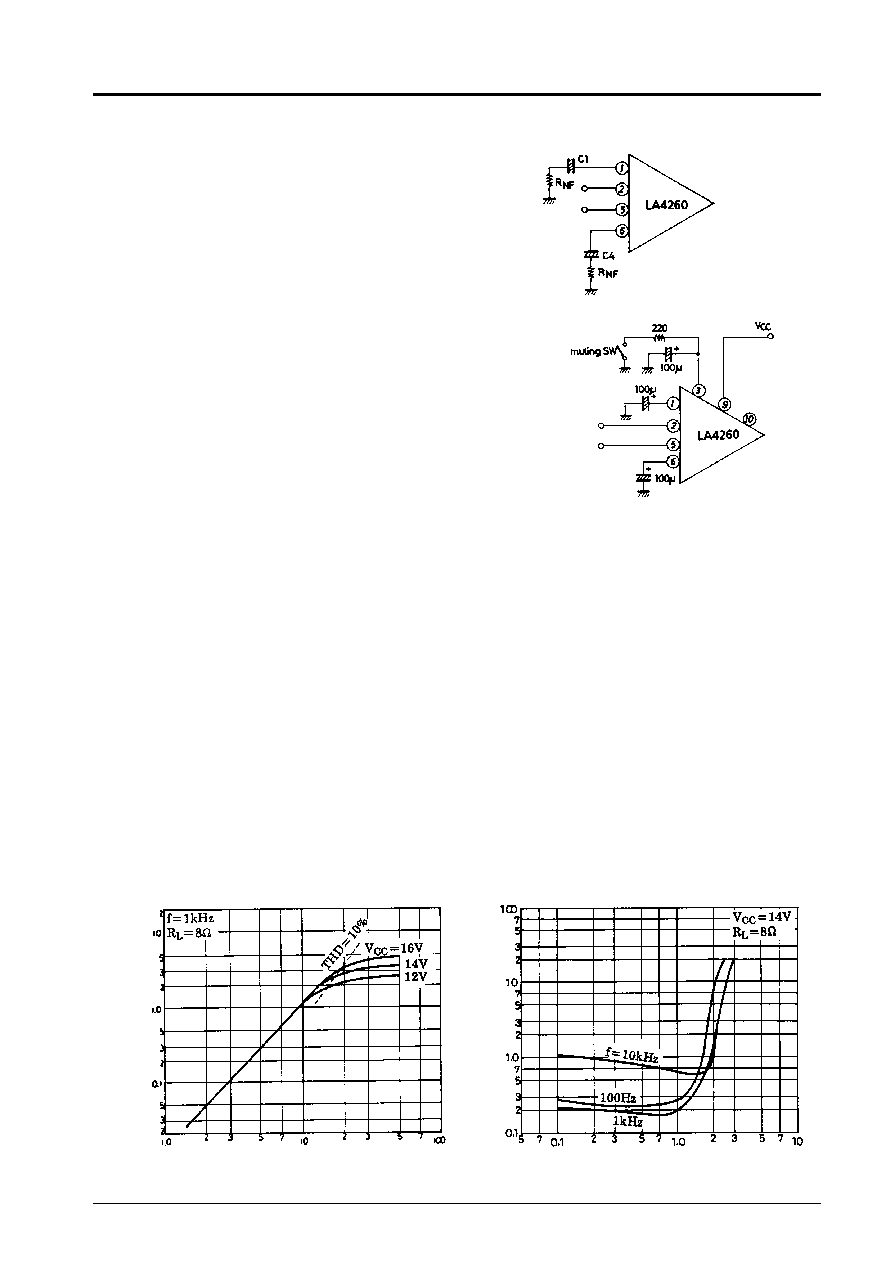- 您現(xiàn)在的位置:買賣IC網(wǎng) > PDF目錄30717 > LA4260 2.5 W, 2 CHANNEL, AUDIO AMPLIFIER, PSFM10 PDF資料下載
參數(shù)資料
| 型號: | LA4260 |
| 元件分類: | 音頻/視頻放大 |
| 英文描述: | 2.5 W, 2 CHANNEL, AUDIO AMPLIFIER, PSFM10 |
| 文件頁數(shù): | 4/8頁 |
| 文件大小: | 242K |
| 代理商: | LA4260 |

Note for Changing Voltage Gain
Basically, the voltage gain can be reduced by adding external
resistors (RNF) in series with feedback capacitors C1, C4.
However, it should be noted that since there is no phase
compensation pin the frequency response is extended and
oscillation is liable to occur when the voltage gain is reduced.
The voltage gain must not be reduced to be less than 30 dB.
External Muting
If external muting is required, make the circuit as shown right.
In this case, the attack time, recovery time, and pop noise are
similar to those which occur at the time of power switch
ON/OFF.
Proper Cares in Using IC
.
Maximum ratings
If the IC is used in the vicinity of the maximum ratings, even a slight variation in conditions may cause the maximum ratings to
be exceeded, thereby leading to breakdown. Allow an ample margin of variation for supply voltage, etc. and use the IC in the
range where the maximum ratings are not exceeded.
.
Pin-to-pin short
If power is applied when the space between pins is shorted, breakdown or deterioration may occur. When mounting the IC on
the board or applying power, make sure that the space between pins is not shorted with solder, etc.
.
When using in radios, allow a sufficient space between IC and bar antenna.
.
Printed circuit pattern
When designing the printed circuit pattern, make the power supply, output, and ground lines thick and short and arrange the
pattern and parts so that no feedback loop is formed between input and output. Place power capacitor C9, oscillation blocking
capacitors C6, C8 as close to IC pins as possible to prevent oscillation from occurring. Refer to the sample printed circuit
pattern.
Unit (resistance:
, capacitance: F)
PO –VIN
Output
power
,
P
O
–W
Input voltage, VIN –mV
THD–PO
T
otal
harmonic
distortion,
THD
–
%
Output power, PO –W
LA4260
No.5644-4/8
相關(guān)PDF資料 |
PDF描述 |
|---|---|
| LA4261 | 3.5 W, 2 CHANNEL, AUDIO AMPLIFIER, PSFM10 |
| LA4265 | 3.5 W, 1 CHANNEL, AUDIO AMPLIFIER, PSFM10 |
| LA4266 | 3 W, 1 CHANNEL, AUDIO AMPLIFIER, PSFM10 |
| LA4267 | 5 W, 1 CHANNEL, AUDIO AMPLIFIER, PSFM10 |
| LA4268 | 10 W, 1 CHANNEL, AUDIO AMPLIFIER, PSFM10 |
相關(guān)代理商/技術(shù)參數(shù) |
參數(shù)描述 |
|---|---|
| LA4261 | 制造商:Panasonic Industrial Company 功能描述:IC |
| LA4265 | 制造商:SANYO 制造商全稱:Sanyo Semicon Device 功能描述:2-CHANNEL AF POWER AMP FOR TAPE RECORDER RADIO |
| LA4266 | 制造商:SANYO 制造商全稱:Sanyo Semicon Device 功能描述:3 W Monaural Power Amplifier |
| LA4267 | 制造商:SANYO 制造商全稱:Sanyo Semicon Device 功能描述:5 W Monaural Power Amplifier |
| LA4268 | 制造商:SANYO 制造商全稱:Sanyo Semicon Device 功能描述:10 W Monaural Power Amplifier |
發(fā)布緊急采購,3分鐘左右您將得到回復(fù)。